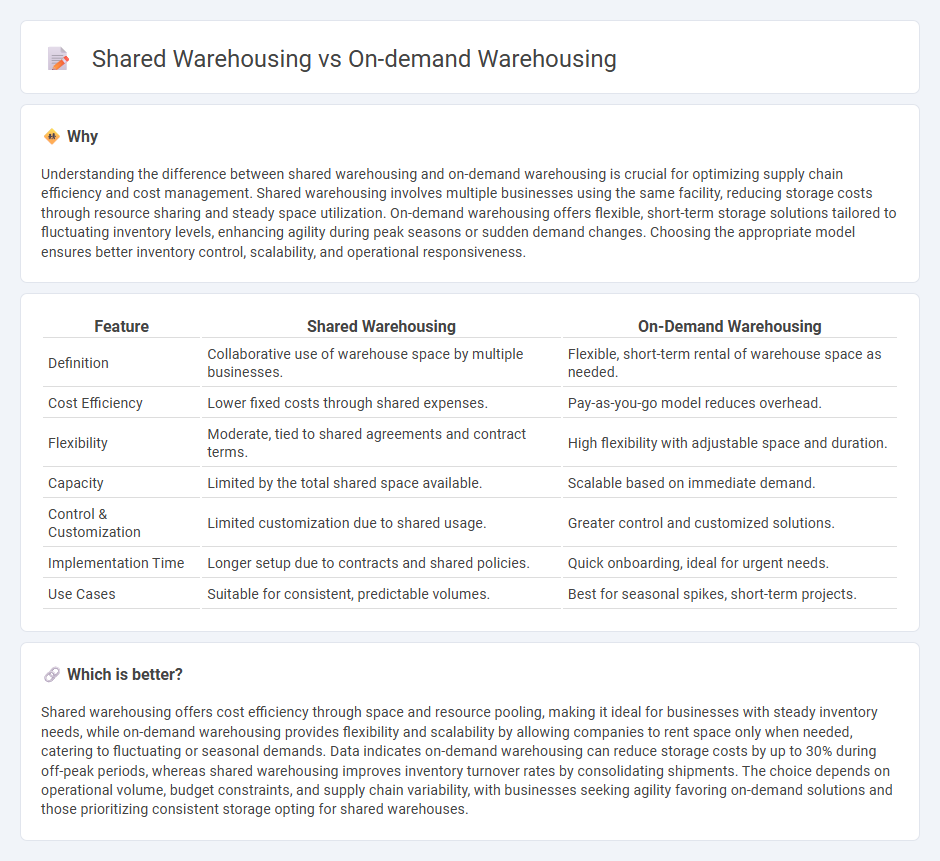
Shared warehousing maximizes space utilization by allowing multiple businesses to store goods in a common facility, reducing costs through economies of scale. On-demand warehousing offers flexible storage solutions, enabling companies to scale warehouse space up or down based on real-time inventory needs without long-term contracts. Discover more about how these logistics strategies can optimize your supply chain efficiency.
Why it is important
Understanding the difference between shared warehousing and on-demand warehousing is crucial for optimizing supply chain efficiency and cost management. Shared warehousing involves multiple businesses using the same facility, reducing storage costs through resource sharing and steady space utilization. On-demand warehousing offers flexible, short-term storage solutions tailored to fluctuating inventory levels, enhancing agility during peak seasons or sudden demand changes. Choosing the appropriate model ensures better inventory control, scalability, and operational responsiveness.
Comparison Table
| Feature | Shared Warehousing | On-Demand Warehousing |
|---|---|---|
| Definition | Collaborative use of warehouse space by multiple businesses. | Flexible, short-term rental of warehouse space as needed. |
| Cost Efficiency | Lower fixed costs through shared expenses. | Pay-as-you-go model reduces overhead. |
| Flexibility | Moderate, tied to shared agreements and contract terms. | High flexibility with adjustable space and duration. |
| Capacity | Limited by the total shared space available. | Scalable based on immediate demand. |
| Control & Customization | Limited customization due to shared usage. | Greater control and customized solutions. |
| Implementation Time | Longer setup due to contracts and shared policies. | Quick onboarding, ideal for urgent needs. |
| Use Cases | Suitable for consistent, predictable volumes. | Best for seasonal spikes, short-term projects. |
Which is better?
Shared warehousing offers cost efficiency through space and resource pooling, making it ideal for businesses with steady inventory needs, while on-demand warehousing provides flexibility and scalability by allowing companies to rent space only when needed, catering to fluctuating or seasonal demands. Data indicates on-demand warehousing can reduce storage costs by up to 30% during off-peak periods, whereas shared warehousing improves inventory turnover rates by consolidating shipments. The choice depends on operational volume, budget constraints, and supply chain variability, with businesses seeking agility favoring on-demand solutions and those prioritizing consistent storage opting for shared warehouses.
Connection
Shared warehousing and on-demand warehousing both optimize storage space by allowing multiple businesses to use a common facility, reducing costs and improving efficiency. Shared warehousing involves long-term collaborative use of warehouse space, while on-demand warehousing offers flexible, short-term storage solutions tailored to fluctuating inventory needs. The connection between the two lies in maximizing asset utilization and providing scalable logistics solutions for dynamic supply chain demands.
Key Terms
**On-demand warehousing:**
On-demand warehousing offers flexible storage solutions that adapt to fluctuating inventory needs, reducing fixed costs and improving supply chain efficiency. Unlike shared warehousing, it provides dedicated space as required, ensuring enhanced control and faster access to goods. Explore how on-demand warehousing can optimize your inventory management and operational agility.
Flexibility
On-demand warehousing offers unparalleled flexibility by allowing businesses to scale storage space up or down based on real-time needs without long-term commitments. Shared warehousing provides cost efficiency through space-sharing but may limit customization and rapid adaptability due to fixed allocations and collective usage. Explore the advantages and distinctions of these models to determine the optimal storage solution for your supply chain needs.
Scalability
On-demand warehousing offers unparalleled scalability by allowing businesses to flexibly adjust storage space based on fluctuating inventory levels, avoiding long-term commitments typical of shared warehousing. Shared warehousing provides cost efficiency through pooled resources but often lacks the rapid scalability needed during peak seasons or sudden demand surges. Explore how scalable storage solutions can optimize your supply chain management.
Source and External Links
On-Demand Warehouse: Definition, Examples, and Uses - On-demand warehousing is a flexible and cost-effective storage solution allowing businesses to rent warehouse space only when needed, enabling scalability and improved supply chain efficiency, especially for fluctuating inventory demands such as in eCommerce.
On-Demand Warehousing 101: What is On-Demand Warehousing - This model offers brands and retailers scalable warehousing by connecting them with providers who have excess capacity through a marketplace and pay-as-you-go pricing, eliminating long-term contracts and setup fees.
On-demand Warehousing Market Size & Share Report, 2030 - The global market for on-demand warehousing was valued at nearly $9.7 billion in 2023 and is expected to grow at a compound annual rate of 15.3% through 2030, driven by eCommerce growth, technology advancements, and the need for flexible, short-term storage and fulfillment services.
 dowidth.com
dowidth.com